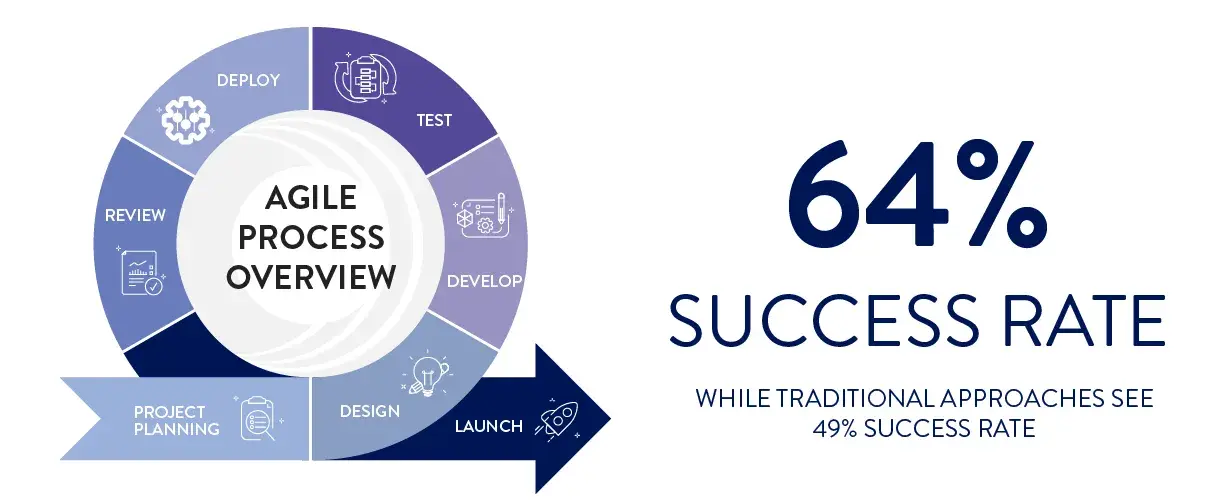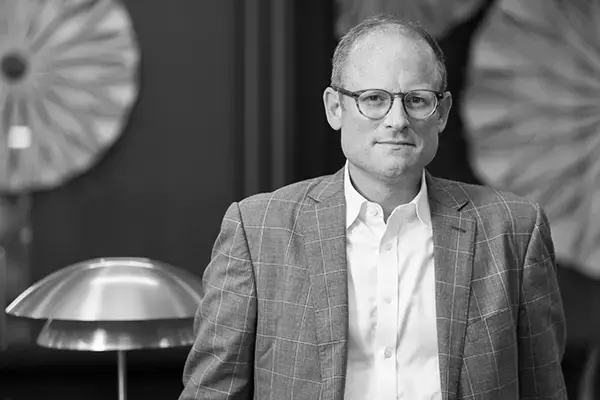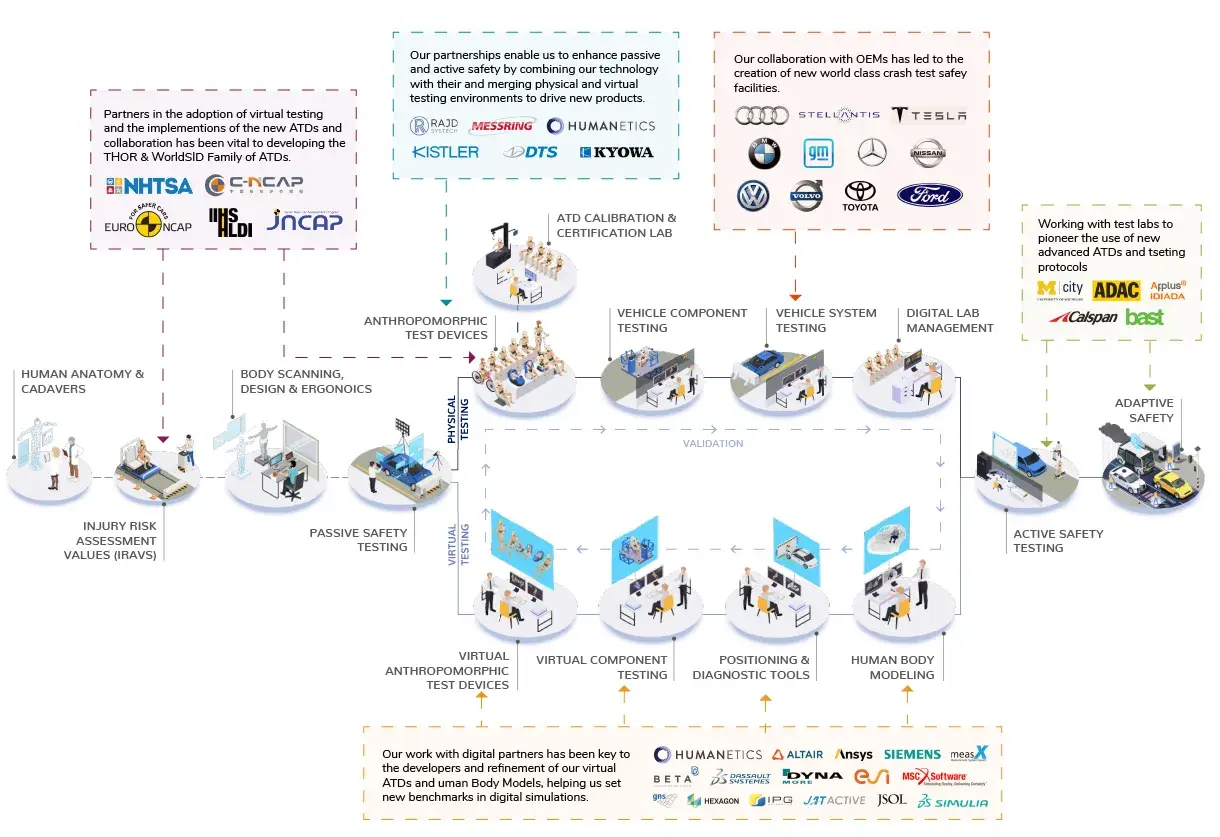"Great things in business are never done by one person; they're done by a team of people." - Steve Jobs
To create truly integrated products, we need to work together every step of the way. When we kick off projects using Agile methods, we see real results—up to a 64% success rate, compared to just 49% with traditional approaches. It’s proof that collaboration and flexibility really do make a difference.
Real progress, whether improving efficiency, reducing risk, or saving lives, happens only through collaboration. No organization can solve today’s safety challenges alone, which is why we eagerly partner with industry leaders, researchers, and technology innovators. We are hungry for complex problems to solve with safety and technology partners. This collaborative mindset drives the development of advanced safety solutions and keeps us at the forefront of our field.
A Commitment to Collaboration
Our commitment to collaboration is evident in our proactive response to the latest Euro NCAP and NHTSA roadmaps, as well as our ongoing dialogue with the industry. The Euro NCAP collaborative model, in particular, exemplifies how structured, transparent, and inclusive partnerships, regularly bringing together automotive manufacturers, suppliers, research consortia, and regulatory bodies, can forge consensus on safety standards and testing protocols, as demonstrated in its Vision 2030 roadmap. By uniting diverse teams and perspectives in this way, we accelerate the adoption of advanced safety features and ensure that all industry voices contribute to shaping a safer, more innovative future for all.
Agile Partnerships in Action
We have numerous instances of our close collaboration with a broad network of industry leaders, OEMS, Tier 1s, research institutions, and regulatory agencies, all united by the goal of advancing integrated safety innovation.

The Cohort-Based Advantage
Through these partnerships, we can achieve:
Faster Time to Market
By partnering with Messring to integrate their advanced soft target technologies with our platforms and collaborating with OEMs like Nissan and Hyundai to establish world-class crash test safety facilities, we accelerate the development, deployment, and delivery of active safety solutions to customers more quickly and efficiently.
Integrated, High-Performance Products
At Mcity, we merge physical and virtual testing environments to drive new research in active safety, resulting in robust, high-performance products validated in both real and simulated scenarios, while our collaboration with Virtual Vehicle and DSD has been instrumental in developing and refining the Human Body Model, setting new benchmarks in digital human simulation and predictive safety analytics.
Expanding Research and Expertise
Collaborations with automotive technology and research centers such as CATARC and CAERI have enabled us to pioneer the use of our THOR-AV in crash testing protocols tailored for reclined seating and autonomous vehicles, while our support of the OSU Injury Biomechanics Research Center advances groundbreaking human safety research and helps train the next generation of safety engineers and researchers.
Continuous Innovation and Validation
Through our partnership with Euro NCAP, we have supported the adoption of virtual testing and the implementation of the new THOR-50M ATD; our decade-long collaboration with NHTSA has been vital to developing the THOR family of ATDs and advancing regulatory safety standards; the University of Virginia serves as an early “test lab” for our latest safety developments, providing essential validation and feedback; and our ongoing partnership with IIHS ensures we remain at the forefront of vehicle and roadway safety, continually contributing to the advancement of industry best practices.
Partnership-Driven Agile Model
Part one of our “Safety as a Mission” articles underscores how industry alignment and collaborative models are essential to accelerate progress toward goals like Vision Zero. The pace of change is now further amplified by digital transformation and AI, which enable real-time data sharing, predictive analytics, and rapid integration of new safety technologies. These advances not only shorten development cycles but also allow for more dynamic responses to emerging risks, making it possible to meet ambitious safety timelines that were previously out of reach. In this environment, collaborative models like Euro NCAP’s are more critical than ever, serving as platforms where innovation, regulation, and mission-driven leadership converge to drive the industry forward at the speed of technological change.
Partnership means more than just working together. It’s about building real connections based on trust, flexibility, and open conversation. By teaming up with partners in small, diverse groups, we make sure our product development stays fast, adaptable, and truly collaborative. This hands-on, Agile way of working doesn’t just feel better; it gets results, with projects seeing a 64% success rate, much higher than traditional methods.

The Agile Model of Development is a framework for building synergistic ecosystems. Startups and established companies alike leverage this model to combine the speed and creativity of emerging firms with the resources and experience of industry leaders. The result is a dynamic environment where innovation flourishes, risk is shared, and mutual growth is the norm.

The Future is Integrated—and Agile
In today’s fast-moving world, staying ahead means being able to innovate quickly and safely. By working together in close, Agile partnerships, organizations can move faster, stay competitive, and tap into the unique expertise they need to succeed. The Agile Partnership Model isn’t just a process—it’s a vital approach that helps teams create the safer, smarter products that will shape our future.
As we move forward with our Safety as a Mission series, one thing stands out: the future will be shaped by those who dare to collaborate, adapt quickly, and keep learning every step of the way. For us, integration isn’t just a box to check, it’s how we move forward and make real progress together.
UP NEXT: We conclude the series by connecting how an integrated ecosystem, advanced technology, and collaboration with partners can deliver the outcomes needed to fulfil the purpose of Safety as a Mission.
Our 'Safety as a Mission' article series covers several key topics in advancing safety technology to save lives. Click the articles below to continue reading about 'Safety as a Mission:
- Part 1: Embracing the Integrated Ecosystem
- Part 2: Our Shared Mission is to Prevent Millions from Dying
- Part 3: A Vision Inspires Hope. A Mission Demands Action
- Part 4: Equitable Design: Design for Every Body
- Part 5: Pedestrians Take a Hit
- Part 6: Next Generation ATDs & the Connected Lab
- Part 7: Welcome to the Proving Grounds: Smart Testing for Crash Prevention
- Part 8: Partnership as an Accelerator: The Agile Model of Development
- Part 9: Conclusion: Safety as a Mission: The Need for Action.
Want to Read More?
Subscribe to the Humanetics Pulse newsletter to learn more about safety as a mission and the full ecosystem.

Barney Loehnis
Barney is the President of Humanetics Sensors & Chief Marketing Officer, leading our Sensor group and marketing growth programs, strategic communications, and customer experience design. He has led marketing and digital transformations in Europe, Asia and the USA in B2B, B2C and agency sectors, for clients like IBM, VW, Huawei, Qualcomm and Mercer Consulting. Barney is a British and American citizen, a bad runner and avid cook.
